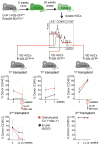Analysis of histone 2B-GFP retention reveals slowly cycling hematopoietic stem cells
- PMID: 19060879
- PMCID: PMC2805441
- DOI: 10.1038/nbt.1517
Analysis of histone 2B-GFP retention reveals slowly cycling hematopoietic stem cells
Abstract
Hematopoietic stem cells (HSCs) are thought to divide infrequently based on their resistance to cytotoxic injury targeted at rapidly cycling cells and have been presumed to retain labels such as the thymidine analog 5-bromodeoxyuridine (BrdU). However, BrdU retention is neither a sensitive nor specific marker for HSCs. Here we show that transient, transgenic expression of a histone 2B (H2B)-green fluorescent protein (GFP) fusion protein in mice has several advantages for label-retention studies over BrdU, including rapid induction of H2B-GFP in virtually all HSCs, higher labeling intensity and the ability to prospectively study label-retaining cells, which together permit a more precise analysis of division history. Mathematical modeling of H2B-GFP dilution in HSCs, identified with a stringent marker combination (L(-)K(+)S(+)CD48(-)CD150(+)), revealed unexpected heterogeneity in their proliferation rates and showed that approximately 20% of HSCs divide at an extremely low rate (< or =0.8-1.8% per day).
Figures




References
-
- Lerner C, Harrison DE. 5-Fluorouracil spares hemopoietic stem cells responsible for long-term repopulation. Exp Hematol. 1990;18:114–8. - PubMed
-
- Kiel MJ, et al. SLAM family receptors distinguish hematopoietic stem and progenitor cells and reveal endothelial niches for stem cells. Cell. 2005;121:1109–21. - PubMed
-
- Arai F, et al. Tie2/angiopoietin-1 signaling regulates hematopoietic stem cell quiescence in the bone marrow niche. Cell. 2004;118:149–61. - PubMed
Publication types
MeSH terms
Substances
Grants and funding
LinkOut - more resources
Full Text Sources
Other Literature Sources
Molecular Biology Databases
Research Materials
Miscellaneous

